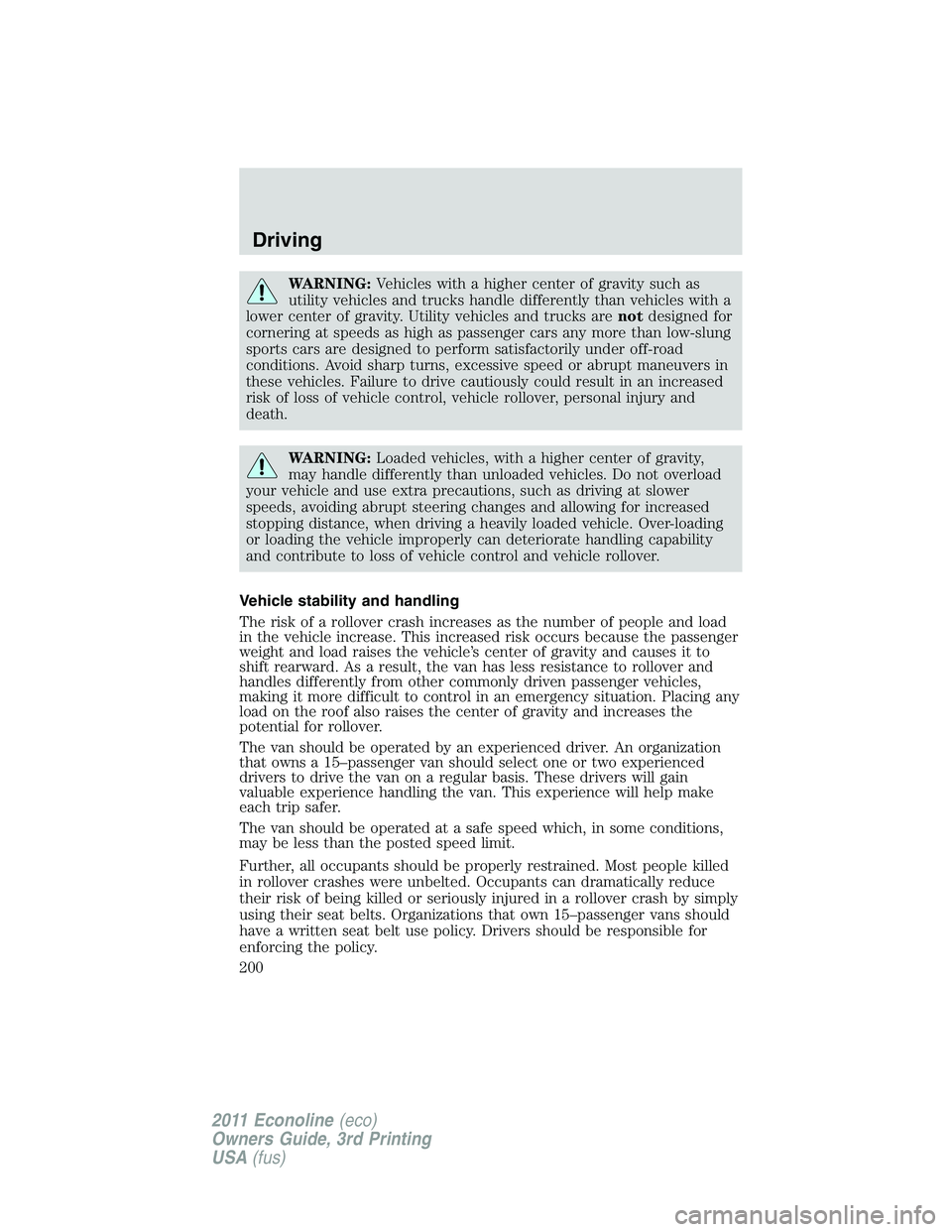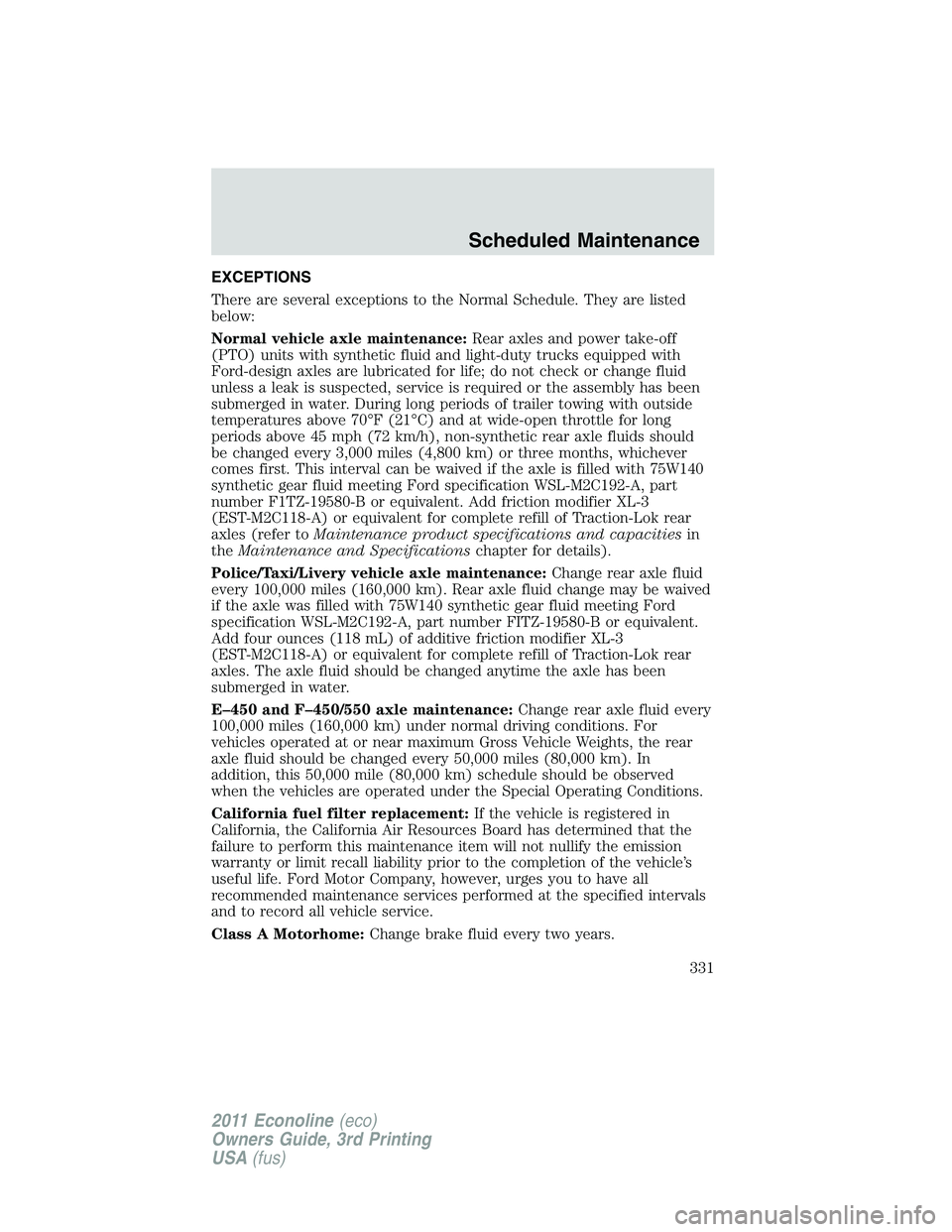2011 FORD E150 weight
[x] Cancel search: weightPage 177 of 339

EngineRear axle
ratioMaximum
GCWR - lb (kg)Maximum Trailer
Weight - lb (kg)
E-350 Cutaway Dual Rear Wheel (DRW) 138” Wheelbase
5.4L 3.73 10050 (4763) 4900 (2223)
5.4L 4.10 13000 (5897) 7700 (3493)
6.8L 4.10 18500 (8391) 10000 (4536)
E-350 Cutaway Single Rear Wheel (SRW) 158” Wheelbase
5.4L 3.73 9600 (4354) 4600 (2087)
5.4L 4.10 13000 (5896) 8000 (3629)
6.8L 4.10 18500 (8391) 10000 (4536)
E-350 Cutaway Dual Rear Wheel (DRW) 158”/176” Wheelbase
5.4L 3.73 10050 (4763) 4800 (2177)
5.4L 4.10 13000 (5897) 7700 (3493)
6.8L 4.10 18500 (8391) 10000 (4536)
E-350 Stripped Chassis Single Rear Wheel (SRW) 138”
Wheelbase
5.4L 3.73/4.10 13000 (5897) 8700 (3946)
E-350 Stripped Chassis Single Rear Wheel (SRW) 158”
Wheelbase
5.4L 3.73/4.10 13000 (5897) 8600 (3901)
E-350 Stripped Chassis Dual Rear Wheel (DRW) 138” Wheelbase
5.4L 4.10 13000 (5897) 8400 (3810)
6.8L 4.10 18500 (8391) 10000 (4536)
E-350 Stripped Chassis Dual Rear Wheel (DRW) 158”/176”
Wheelbase
5.4L 4.10 13000 (5897) 8300 (3765)
6.8L 4.10 18500 (8391) 10000 (4536)
E-450 Cutaway
5.4L 4.56 14050 (6373) 8500 (3856)
6.8L 4.56 22000 (9979) 10000 (4536)
E-450 Stripped Chassis
5.4L 4.56 14050 (6373) 9200 (4173)
6.8L 4.56 22000 (9979) 10000 (4536)
Tires, Wheels and Loading
177
2011 Econoline(eco)
Owners Guide, 3rd Printing
USA(fus)
Page 178 of 339

Notes:
•Maximum trailer weight for all cutaway vehicles must be calculated by
subtracting the weight of the vehicle (including incomplete vehicle
weight and payload which includes second unit body weight, cargo
and passengers) from the GCW; otherwise, maximum trailer weight is
10,000 lb (4,536 kg).
•For high altitude operation reduce GCWR by 2% per 1,000 ft (300 m)
elevation.
•To determine the maximum trailer weight designed for your particular
vehicle as equipped, follow the instructions inVehicle loading - with
and without a trailerearlier in this chapter.
Preparing to tow
Use the proper equipment for towing a trailer and make sure it is
properly attached to your vehicle. Contact your authorized dealer or a
reliable trailer dealer as soon as possible if you require assistance.
Hitches
Do not use or install a hitch that clamps onto the vehicle’s bumper or to
the axle. An underbody hitch is acceptable if it is installed properly.
Using a step bumper (if equipped)
The rear bumper is equipped with an integral hitch and only requires a
ball with a one inch (25.4 mm) shank diameter. The bumper has a
5,000 lb (2,270 kg) trailer weight and 500 lb (227 kg) tongue weight
capacity.
If it is necessary to relocate the trailer hitch ball position, a
frame-mounted trailer hitch must be installed.
Safety chains
Always connect the trailer’s safety chains to the frame or hook retainers
of the vehicle hitch. To connect the trailer’s safety chains, cross the
chains under the trailer tongue and allow slack for turning corners.
If you use a rental trailer, follow the instructions that the rental agency
gives to you.
Do not attach safety chains to the bumper.
Tires, Wheels and Loading
178
2011 Econoline(eco)
Owners Guide, 3rd Printing
USA(fus)
Page 200 of 339

WARNING:Vehicles with a higher center of gravity such as
utility vehicles and trucks handle differently than vehicles with a
lower center of gravity. Utility vehicles and trucks arenotdesigned for
cornering at speeds as high as passenger cars any more than low-slung
sports cars are designed to perform satisfactorily under off-road
conditions. Avoid sharp turns, excessive speed or abrupt maneuvers in
these vehicles. Failure to drive cautiously could result in an increased
risk of loss of vehicle control, vehicle rollover, personal injury and
death.
WARNING:Loaded vehicles, with a higher center of gravity,
may handle differently than unloaded vehicles. Do not overload
your vehicle and use extra precautions, such as driving at slower
speeds, avoiding abrupt steering changes and allowing for increased
stopping distance, when driving a heavily loaded vehicle. Over-loading
or loading the vehicle improperly can deteriorate handling capability
and contribute to loss of vehicle control and vehicle rollover.
Vehicle stability and handling
The risk of a rollover crash increases as the number of people and load
in the vehicle increase. This increased risk occurs because the passenger
weight and load raises the vehicle’s center of gravity and causes it to
shift rearward. As a result, the van has less resistance to rollover and
handles differently from other commonly driven passenger vehicles,
making it more difficult to control in an emergency situation. Placing any
load on the roof also raises the center of gravity and increases the
potential for rollover.
The van should be operated by an experienced driver. An organization
that owns a 15–passenger van should select one or two experienced
drivers to drive the van on a regular basis. These drivers will gain
valuable experience handling the van. This experience will help make
each trip safer.
The van should be operated at a safe speed which, in some conditions,
may be less than the posted speed limit.
Further, all occupants should be properly restrained. Most people killed
in rollover crashes were unbelted. Occupants can dramatically reduce
their risk of being killed or seriously injured in a rollover crash by simply
using their seat belts. Organizations that own 15–passenger vans should
have a written seat belt use policy. Drivers should be responsible for
enforcing the policy.
Driving
200
2011 Econoline(eco)
Owners Guide, 3rd Printing
USA(fus)
Page 283 of 339

•Warming up a vehicle on cold mornings is not required and may
reduce fuel economy.
•Resting your foot on the brake pedal while driving may reduce fuel
economy.
•Combine errands and minimize stop-and-go driving.
Maintenance
•Keep tires properly inflated and use only recommended size.
•Operating a vehicle with the wheels out of alignment will reduce fuel
economy.
•Use recommended engine oil. Refer toMaintenance product
specifications and capacitiesin this chapter.
•Perform all regularly scheduled maintenance items. Follow the
recommended maintenance schedule and owner maintenance checks
found inscheduled maintenance information.
Conditions
•Heavily loading a vehicle or towing a trailer may reduce fuel economy
at any speed.
•Carrying unnecessary weight may reduce fuel economy (approximately
1 mpg [0.4 km/L] is lost for every 400 lb [180 kg] of weight carried).
•Adding certain accessories to your vehicle (for example bug
deflectors, rollbars/light bars, running boards, ski racks) may reduce
fuel economy.
•Using fuel blended with alcohol may lower fuel economy.
•Fuel economy may decrease with lower temperatures during the first
8–10 miles (12–16 km) of driving.
•Driving on flat terrain offers improved fuel economy as compared to
driving on hilly terrain.
•Transmissions give their best fuel economy when operated in the top
cruise gear and with steady pressure on the gas pedal.
•Close windows for high speed driving.
Maintenance and Specifications
283
2011 Econoline(eco)
Owners Guide, 3rd Printing
USA(fus)
Page 305 of 339

Vehicle identification number (VIN)
The vehicle identification number is
located on the driver side
instrument panel or on the
certification label.
Please note that in the graphic,
XXXX is representative of your
vehicle identification number.
The vehicle identification number (VIN) contains the following
information:
1. World manufacturer identifier
2. Brake system / Gross Vehicle
Weight Rating (GVWR) / Restraint
Devices and their location
3. Make, vehicle line, series, body
type
4. Engine type
5. Check digit
6. Model year
7. Assembly plant
8. Production sequence number
Certification label for incomplete vehicles
On completed derivations of incomplete vehicles, the certification label is
affixed at a location determined by a subsequent stage manufacturer of
the completed vehicle. In these cases the completed vehicle is
manufactured in two or more stages by two or more separate
manufacturers.
XXXXXXXXXXXXXXXXX
Maintenance and Specifications
305
2011 Econoline(eco)
Owners Guide, 3rd Printing
USA(fus)
Page 308 of 339

Peace of mind
•Keyless entry keypad•Back up camera*
•Remote start•Back up alarm*
•Vehicle security systems•Hitch mounted parking sensor*
•Vehicle tracking and recovery*
•Bumper mounted parking sensors*
*Ford Licensed Accessories (FLA) are warranted by the accessory
manufacturer’s warranty. Ford Licensed Accessories are fully designed
and developed by the accessory manufacturer and have not been
designed or tested to Ford Motor Company engineering requirements.
Contact your Ford dealer for details regarding the manufacturer’s limited
warranty and/or a copy of the FLA product limited warranty offered by
the accessory manufacturer.
For maximum vehicle performance, keep the following information in
mind when adding accessories or equipment to your vehicle:
•When adding accessories, equipment, passengers and luggage to your
vehicle, do not exceed the total weight capacity of the vehicle or of
the front or rear axle (GVWR or GAWR as indicated on the Safety
Compliance Certification label). Consult your authorized dealer for
specific weight information.
•
The Federal Communications Commission (FCC) and Canadian Radio
Telecommunications Commission (CRTC) regulate the use of mobile
communications systems — such as two-way radios, telephones and
theft alarms - that are equipped with radio transmitters. Any such
equipment installed in your vehicle should comply with FCC or CRTC
regulations and should be installed only by a qualified service technician.
•Mobile communications systems may harm the operation of your vehicle,
particularly if they are not properly designed for automotive use.
•To avoid interference with other vehicle functions, such as anti-lock
braking systems, amateur radio users who install radios and antennas
onto their vehicle should not locate the Amateur Radio Antennas in
the area of the driver’s side hood.
•Electrical or electronic accessories or components that are added to
the vehicle by the authorized dealer or the owner, may adversely
affect battery performance and durability, and may also adversely
affect the performance of other electrical systems in the vehicle.
Accessories
308
2011 Econoline(eco)
Owners Guide, 3rd Printing
USA(fus)
Page 331 of 339

EXCEPTIONS
There are several exceptions to the Normal Schedule. They are listed
below:
Normal vehicle axle maintenance:Rear axles and power take-off
(PTO) units with synthetic fluid and light-duty trucks equipped with
Ford-design axles are lubricated for life; do not check or change fluid
unless a leak is suspected, service is required or the assembly has been
submerged in water. During long periods of trailer towing with outside
temperatures above 70°F (21°C) and at wide-open throttle for long
periods above 45 mph (72 km/h), non-synthetic rear axle fluids should
be changed every 3,000 miles (4,800 km) or three months, whichever
comes first. This interval can be waived if the axle is filled with 75W140
synthetic gear fluid meeting Ford specification WSL-M2C192-A, part
number F1TZ-19580-B or equivalent. Add friction modifier XL-3
(EST-M2C118-A) or equivalent for complete refill of Traction-Lok rear
axles (refer toMaintenance product specifications and capacitiesin
theMaintenance and Specificationschapter for details).
Police/Taxi/Livery vehicle axle maintenance:Change rear axle fluid
every 100,000 miles (160,000 km). Rear axle fluid change may be waived
if the axle was filled with 75W140 synthetic gear fluid meeting Ford
specification WSL-M2C192-A, part number FITZ-19580-B or equivalent.
Add four ounces (118 mL) of additive friction modifier XL-3
(EST-M2C118-A) or equivalent for complete refill of Traction-Lok rear
axles. The axle fluid should be changed anytime the axle has been
submerged in water.
E–450 and F–450/550 axle maintenance:Change rear axle fluid every
100,000 miles (160,000 km) under normal driving conditions. For
vehicles operated at or near maximum Gross Vehicle Weights, the rear
axle fluid should be changed every 50,000 miles (80,000 km). In
addition, this 50,000 mile (80,000 km) schedule should be observed
when the vehicles are operated under the Special Operating Conditions.
California fuel filter replacement:If the vehicle is registered in
California, the California Air Resources Board has determined that the
failure to perform this maintenance item will not nullify the emission
warranty or limit recall liability prior to the completion of the vehicle’s
useful life. Ford Motor Company, however, urges you to have all
recommended maintenance services performed at the specified intervals
and to record all vehicle service.
Class A Motorhome:Change brake fluid every two years.
Scheduled Maintenance
331
2011 Econoline(eco)
Owners Guide, 3rd Printing
USA(fus)